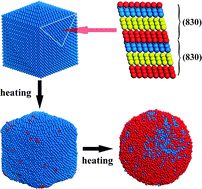Thermal and shape stability of high-index-faceted rhodium nanoparticles: a molecular dynamics investigation
Abstract
Nanosized noble metallic particles enclosed by high-index facets exhibit superior catalytic activity because of their high density of low-coordinated step atoms at the surface, and thus have attracted growing interest over the past decade. In this article, we employed molecular dynamics simulations to investigate the thermodynamic evolution of tetrahexahedral Rh nanoparticles respectively covered by {210}, {310}, and {830} facets during the heating process. Our results reveal that the {210} faceted nanoparticle exhibits better thermal and shape stability than the {310} and {830} faceted ones. Meanwhile, because the {830} facet consists of {210} and {310} subfacets, the stability of the {830} faceted Rh nanoparticle is dominated by the {310} subfacet, which possesses a relatively poor stability. Furthermore, the shape transformation of these nanoparticles occurs much earlier than their melting. Further analyses indicate that surface atoms with higher coordination numbers display lower surface diffusivity, and are thus more helpful for stabilizing the particle shape. This study offers an atomistic understanding of the thermodynamic behaviors of high-index-faceted Rh nanoparticles.


 Please wait while we load your content...
Please wait while we load your content...